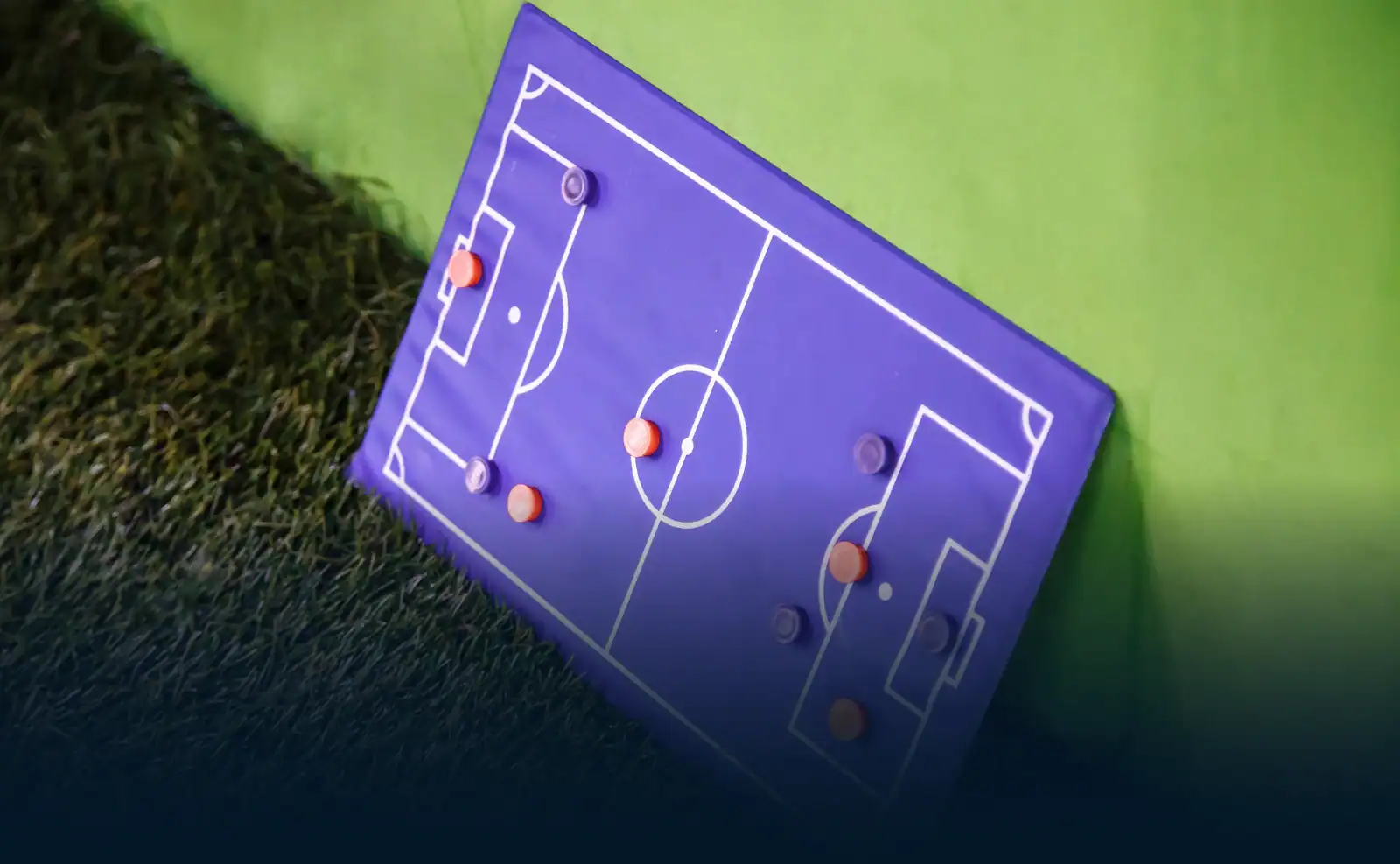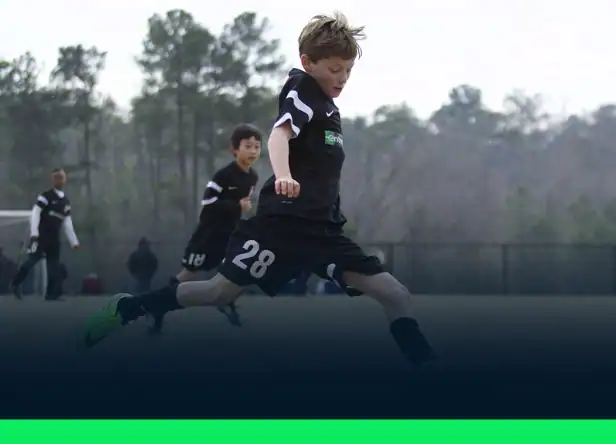The success of a soccer team largely depends on well-thought-out tactics. Among the various soccer tactics, the 3-4-3 stands out as an offensive formation. Discover the key elements of this tactic by exploring its definition, the challenges of its implementation, as well as its differences from other tactical setups.
What is the 3-4-3 formation?
The 3-4-3 or 343, is a tactical formation in soccer that features 3 defenders, 4 midfielders and 3 forwards.
In detail, this approach is characterized by:
- the “3” refers to the three defenders lined up at the back
- the “4” represents the four midfielders positioned in front of the defense (either flat or in a diamond shape)
- the “3” indicates the three forwards
This tactic is designed to be offensive, focusing mainly on exploiting the spaces on the wings through its wide midfielders.
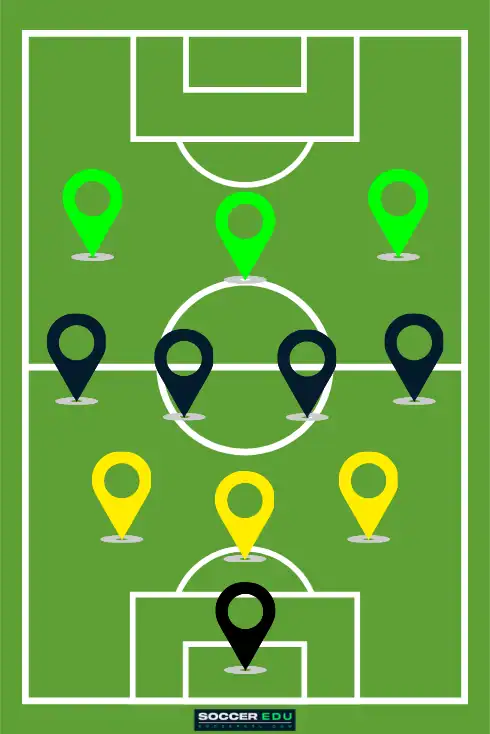
How is the 3-4-3 played?
Playing in a 3-4-3
In a tactic as carefully designed as the 3-4-3, every detail matters. The coach sets up a team with three central defenders, four midfielders and three forwards, each with a specific role to play in executing the strategy.
- The three central defenders form a solid line responsible for protecting the goal and intercepting the opponent’s attacks. They must maintain constant communication and tight coverage to effectively control the defensive space.
- At the heart of this formation are four midfielders, two in the center and two on the sides (which can vary depending on whether the shape is diamond or flat). The two central midfielders act as pivots, orchestrating the transition between defense and attack. They are responsible for winning the ball back, controlling the pace of the game and delivering precise passes to fee the attackers. Meanwhile, the wide midfielders provide width to the play, destabilizing the opposing defense with their speed, dribbling and crosses.
- The three forwards form the spearhead of the team, working together to put pressure on the opposing defense. Their movement, creativity and finishing instinct are essential for generating scoring opportunities and maintaining a constant threat in the opponent’s penalty area.
In my team, the goalkeeper is the first attacker and the striker is the first defender. (Johan Cruyff)
The flat 3-4-3 formation
The flat 3-4-3 is the most common and easiest version of the formation to implement for many teams. In this setup, the four midfielders are positioned horizontally across the field, forming a single line.
This layout provides a balanced distribution of players across the pitch, which helps facilitate coordination and communication among them.
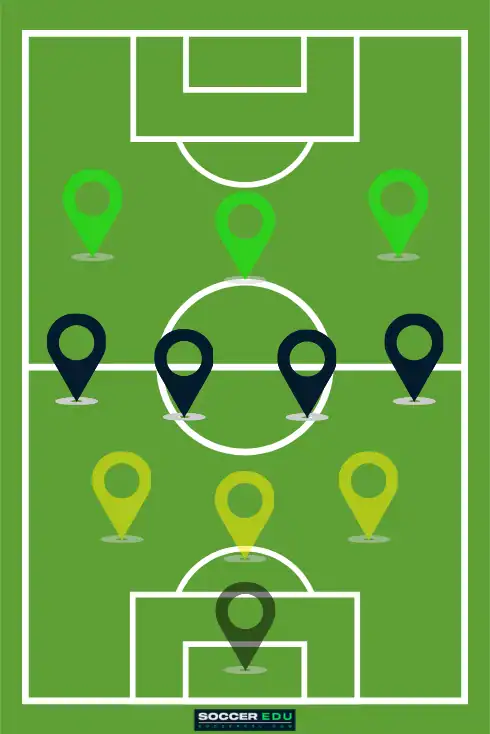
The diamond 3-4-3 formation
The diamond 3-4-3 takes a slightly different tactical approach. In this setup, the four midfielders form a diamond shape on the field, with two central midfielders, one advanced attacking midfielder and one holding defensive midfielder.
This soccer tactic creates a more dynamic structure in midfield, encouraging quick ball circulation and fluid combinations between players.
The advanced attacking midfielders plays higher up the pitch, acting as a vital link between the midfield and the forwards, while the deeper defensive midfielder provides extra support to the back line.
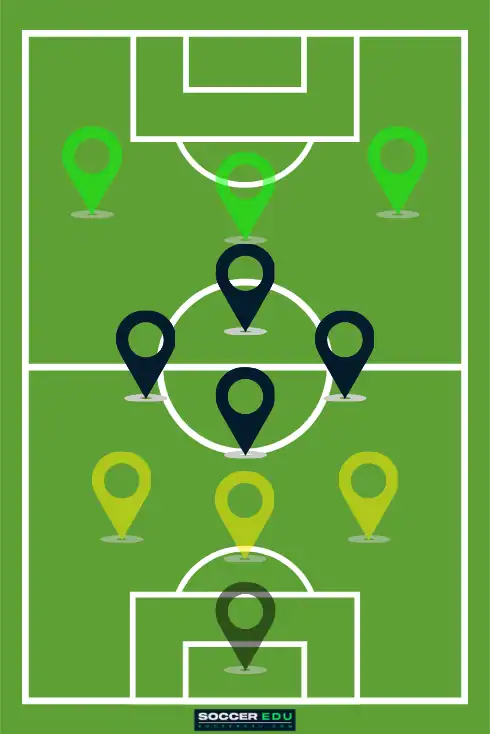
Why play in a 3-4-3 formation?
Pros of the 3-4-3
The choice of the 3-4-3 formation offers several strategic advantage:
- Tactical versatility: The 3-4-3 setup allows a team to quickly adapt to different game situations, shifting from a compact defense to an aggressive attack in an instant.
- Midfield dominance: The midfield is dense and stretches across the width of the field, forcing the opposing defensive block to spread out.
- Reduces space in midfield: With a line of four midfielders, the team aims to close down central areas, pushing the opponent into making mistakes.
- Constant pressure: With three advanced attackers, the team can apply relentless pressure on the opposing defense, limiting their ability to build from the back.
- Key role of wing players: If your wide midfielders (wing-backs) are hard-working and have both defensive and offensive qualities, this formation is very effective.
Cons of the 3-4-3
The choice of the 3-4-3 formation offers several strategic advantages, as outlined above, but naturally, it also comes with certain drawbacks:
- Versatile midfielders: With 4 midfielders, you need players who are versatile, able to switch between offensive and defensive roles.
- Space in behind and counterattacks: With only 3 defenders and advancing full-backs, there’s a greater risk of leaving space behind the defense compared, for example, to a 4-4-2. You also need to stay alert to counterattacks.
- Overworked full-backs: The two fullbacks are heavily involved. Be mindful of their workload, which can quickly become too demanding over 90 minutes.
Teams that have already played in a 3-4-3 formation
Although the 3-4-3 is not the most common formation in Major League Soccer, several clubs have adopted it occasionally to adapt to specific opponents or to make the most of their squad’s strengths.
Use of the 3-4-3 in MLS
- FC Dallas used the 3-4-3 as its primary system during the 2024 preseason and at the start of the 2025 season. According to the specialized outlet 3rd Degree, this formation was employed approximately 90% of the time in spring 2024.
- Under Wilfried Nancy, Columbus Crew started matches in a 3-4-3 (sometimes referred to as 5-2-3 in the defensive phase), notably during the 2025 season opener, according to Massive Report.
4-2-3-1, 4-4-2, 4-2-2-2, or 3-4-3 These are just phone numbers. The most important thing isn’t the system, it’s the idea. (Pep Guardiola)
Use of the 3-4-3 in Europe
1. Antonio Conte’s Chelsea in 2016, and later with Tottenham in 2021. With Chelsea in 2016, the 3-4-3 system helped him win the Premier League with 93 points (30 wins, 3 draws, 5 losses).
2. Pep Guardiola’s FC Barcelona in the 2011/2012 season, where, under the influence of his mentor Johan Curyff, Guardiola alternated between a 4-3-3 and a 3-4-3, implementing his trademark positional play.
These teams demonstrate how the 3-4-3 can be successfully employed at the highest level, both in domestic leagues and international competitions.
Other popular tactics
Although the 3-4-3 has been used less frequently in recent years, there are other formations that are also worth exploring depending on your team’s strengths and weaknesses.
Among them are the 4-3-3, the 3-5-2, the 4-4-2 and the 4-2-3-1, the most commonly used formation in Ligue 1 since 2018, as noted above… and also many more. Each tactic has its own advantages and drawbacks and it’s essential to choose the one that best aligns with your team’s philosophy and game plan.
The 3-4-3 is a strategic soccer formation that can prove highly effective and adaptable to different styles and in-game situations. With precise execution, a strong midfield and hard-working wide players, this setup can become a powerful weapon, as seen with Dallas in MLS or Chelsea in Europe.
As a coach, it’s crucial to consider your team’s strengths and weaknesses, as well as the demand of each match, when choosing the right tactic. Don’t hesitate to experiment with different formations to find the one that suits your team best.

